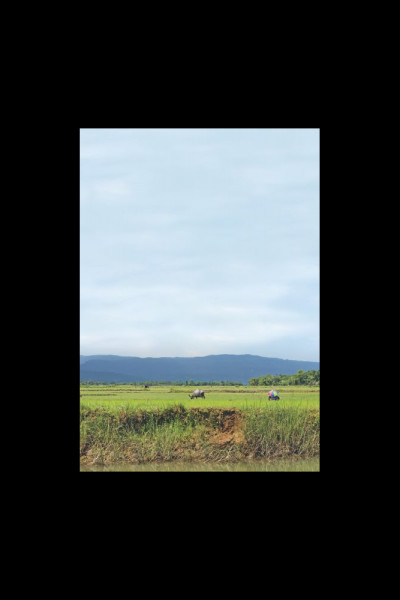The Lost River

It was monsoon then, and the river Piyain and Gowain were supposed to have very strong current. When we paddled our kayaks through these rivers in the month of November a year earlier, they did have strong currents. Back then we had started from Jaflong, and finished at Ratargul swamp forest, 33 km downstream. It took about 10 hours.
This time, the river Piyain was unimaginably slow, perhaps because it had overflown the banks and turned many times wider than usual. On top of that, we had to ride huge waves at places where the serpentine river ran southward and met the monsoon wind coming from the opposite direction.
So we lost our interest in kayaking this river after reaching Gowainghat from where it takes the name Gowain. The decision was a blessing.
When my friend Masud and I were killing time at Gowainghat bazar, I suddenly noticed that a small river met Gowain under a small bridge near the bazaar. After I stood on the bridge to inspect the current, two things surprised me. Firstly, it had comparatively stronger current than Gowain; and secondly, the river was not meeting the Gowain; it was actually heading
north-west.
I know of only one or two rivers that runto the north in Bangladesh. They are located in the hill tracts. I checked google map on my phone and was further amazed. It was not shown on the map. I switched the map type to find blurred traces of the river on Google Earth. That means this river is a seasonal one and wakes up only in the monsoon.

It looked like it ended somewhere near Bichhnakandi, which has been a place of extensive tourist activities for some years now. I immediately decided to kayak and explore this river the next day.
The next morning was calm and the sky was cloudless.We put on our life jackets and started paddling our home-made white water kayaks. With the help of the flow of water, we effortlessly gained a speed of 7-8 km per hour.
The river was running toward the cloud piercing hills of Meghalaya. The green of the trees and the yellow of the crops added to the magnificently picturesque view of the blue river. There were not many houses around. When there was any, we met children who would run away out of some strange fear, calling out others.
Clearly, these children never saw tourists, let alone some weirdly dressed kayakers! Even the elderly looked quite surprised and we had to stop every now and then to satisfy their curiosity. It, of course, provided an opportunity to talk to the local fishermen, farmers, students and all sorts of people.

Soon it was clear that this river did connect Bichnakandi and Gowainghat. When asked, people told us that the name of the river was Piyain. Well, it was confusing, because it was not the same river that flows through Jaflong, although they were connected. So we took the liberty to rename it as Chhoto (lesser) Piyain.
Soon we started crossing big barges. They were transporting stones from Bichhnakandi. We also met some groups of people who were collecting stones from the riverbed and loading their boats. These boats were smaller. Like many other places in northern Sylhet, there were a lot of buffalos and cows, grazing on the river bank.
Paddling past the water buffalos having a bath gave us a thrill. Although they are rather peaceful animals compared to their wild counterparts in the Nijhum Dwip, we were fantasising that those were actually hippos!
The ride was almost a piece of cake, except there were places where the river was whirling threateningly. And they gave us goosebumps because they made it very difficult to keep the nose of the kayaks straight. A small mistake and we would be swimming to Bichhnakandi! And to add danger to the potentially risky scenario, there were barges and trawlers coming from the opposite direction.

After 12 kilometers of paddling, we noticed that the river traffic had increased. There were even bigger vessels plying. We discovered that the place was the famous Hadarpar, from where tourists took boats to go to Bichhnakandi and Panthumai falls.
As we reached near the hills, the current would not help us anymore. We were a bit tired already and the sun was shining overhead with its full brightness, so we decided to head back to our base camp, which was Gowainghat Bungalow. But it was not possible to paddle upstream for such a long distance.

We asked one passing vessel if they would give us a lift, but it was going to Chhatak, not to our direction. However, the next barge was heading towards Gowainghat and they happily agreed to take us. We requested the captain of the boat to stop, but he only slowed the vessel and told us to hop on.
Perhaps he wanted to avoid the hassle of restarting the big engines. It took a little effort to catch the running vessel, throw our paddles on it, get overboard and pick up the kayaks. The kayaks are extremely lightweight, only 5-6 kg, but there were other stuff in them.
Nevertheless, the switching ended well. The crew of the vessel were naturally very enthusiastic about us and our journey. And they were very friendly too. We passed the next few hours gossiping with them, sharing stories.
By Md Ashraful Haque
Photo: Md Ashraful Haque


 For all latest news, follow The Daily Star's Google News channel.
For all latest news, follow The Daily Star's Google News channel. 



Comments